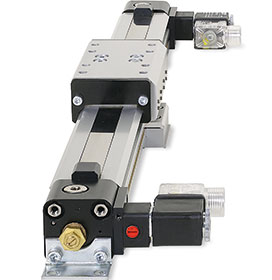

Any engineer tasked with specifying a linear actuator for an industrial automation application, will look for products able to deliver reliability, precision and speed. However, there are numerous other, often overlooked factors that should feature in the purchase decision. Consider rodless linear actuator solutions that integrate 3/2 directional control valves into their end caps; these can prove far more advantageous than deploying control valves separate from the actuators, for a multitude of reasons.
Arguably the most obvious benefit is the potential saving on space. Rodless pneumatic cylinders are used primarily for their compact design. The external carriage slides back and forward along the cylinder body, instead of an external rod extending and retracting. This is especially useful for applications that demand long strokes or elevated moment loads, due to the shorter, enclosed and self-guided configuration.
The benefit of reduced space is enhanced by rodless cylinders that offer valve integration, as well as the inclusion of mounting rails on the sides of the cylinder. These allow modular components such as linear guides, brakes, valves and magnetic switches to be fitted to the cylinder itself, solving many installation problems, especially where space is limited.
Miniaturisation trends
Pneumatics technology continues to play an important role in many modern systems and machines. The ongoing requirement to build smaller machines by taking advantage of more compact components is a driving force behind the use of rodless pneumatic cylinders. These efficient and cost-effective devices offer a high-performance way of moving loads in many different industrial applications, for example, those in the food processing, glass, plastics, textiles and electronics industries. Cutting, packaging, material transfer and sliding-door applications can also be served by rodless linear actuator technology.
Thanks to end caps that can be rotated into various positions, rodless linear actuators provide increased flexibility when it comes to mounting and tubing options. In fact, with some of the latest cylinders, the air connection can be rotated in 4 x 90° steps, while the solenoid can be rotated 4 x 90° and the pilot valve can be rotated 180° (just one air connection is required per valve). In addition, where valves are built into the end caps, the actuation of the rodless cylinder becomes much more direct and dynamic.
Rapid ROI
Downtime is another major factor that should influence the choice of actuator. In an era when downtime can seriously impact ROI, attention should be given to achieving maximum system utilisation. When repairs or replacements need to be performed on rodless linear actuators with integrated directional control valves, system downtime is minimised as there are no external valves with separate air connections to cause concern.
Ultimately, factors such as this contribute greatly to system reliability. Indeed, the reduced number of compressed air connections required as a result of the compact design of these actuators means less tubing, less potential for leakage and overall reduced air consumption.
A greater amount of inherent rigidity in rodless linear actuators also translates into longer lifespan. This design feature derives from the profile design of the cylinder itself, which reduces the tube’s propensity to expand and twist, so that service life can be extended. Rodless cylinders are exceptionally stress-resistant, allowing for a range of possible uses.
High performance
Despite the compact design of rodless cylinders, it should be noted that there is no compromise in technical performance. They allow for easy, precise positioning of the cylinder, smooth operation at the lowest speeds and fast response, making them highly suited to the direct control of production and automation processes. As a point of note, high piston velocities can be achieved, often with a maximum of three exhaust ports, while fully integrated 3/2 directional control valves (N/O function) provide optimal cylinder control through short switching times and high flow rates.
A variety of sizes are available in the marketplace, typically between 25 and 50 mm diameter, and many offer suitability for use under high ambient temperatures, in clean rooms, explosive environments and for low/high speed applications. Stroke lengths beyond 40 metres can be sourced. In fact, rodless air cylinders are the ideal solution for any application that requires a long stroke, as they are not affected by overhang, piston binding, bending or uneven seal wear. Further benefits of many modern rodless linear actuators include an integrated operation indicator, integral exhaust throttle/speed control valve, manual override, silencer function, adjustable end cushioning and ease of retrofitting.
For more information contact Lisa de Beer, Parker Hannifin SA, +27 11 961 0700, lisa.debeer@parker.com, www.parker.com/za
| Tel: | +27 11 961 0700 |
| Fax: | +27 11 392 7213 |
| Email: | parker.southafrica@parker.com |
| www: | www.parker.com/za |
| Articles: | More information and articles about Parker Hannifin - Sales Company South Africa |
© Technews Publishing (Pty) Ltd | All Rights Reserved